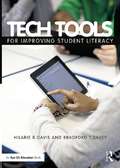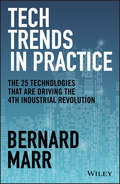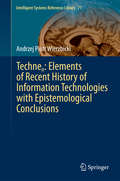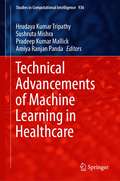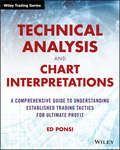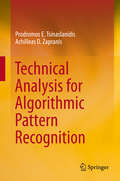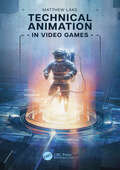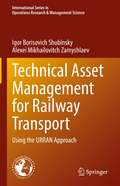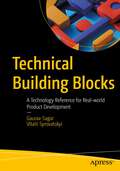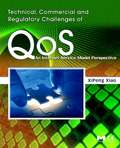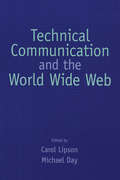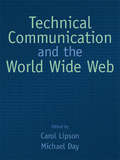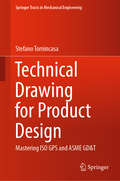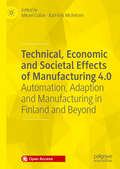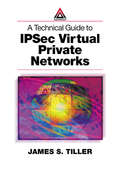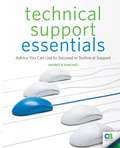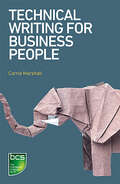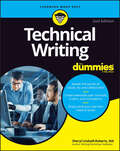- Table View
- List View
Tech Tools for Improving Student Literacy
by Bradford T. Davey Hilarie B. DavisTechnology isn’t just fun to use in the classroom, it can also make real improvements in students’ literacy development. In this book, authors Hilarie Davis and Bradford Davey show you how and why to use tech tools to help enhance the teaching of reading, writing, speaking, listening, and viewing. These tools can be used in English/Language Arts and across the subject areas to promote literacy throughout your school. Special Features: Practical classroom examples from a variety of content areas Connections to specific Common Core State Standards "Using the Technology" boxes with step-by-step guidance on using a tool Screenshots that show how the tools work Strategies to help you use the tools effectively with students
Tech Trends in Practice: The 25 Technologies that are Driving the 4th Industrial Revolution
by Bernard MarrDiscover how 25 powerful technology trends are transforming 21st century businesses How will the latest technologies transform your business? Future Tech Trends in Practice will give you the knowledge of today’s most important technology trends, and how to take full advantage of them to grow your business. The book presents25 real-world technology trends along with their potential contributions to organisational success. You’ll learn how to integrate existing advancements and plan for those that are on the way. In this book, best-selling author, strategic business advisor, and respected futurist Bernard Marr explains the role of technology in providing innovative businesses solutions for companies of varying sizes and across different industries. He covers wide-ranging trends and provides an overview of how companies are using these new and emerging technologies in practice. You, too, can prepare your company for the potential and power of trending technology by examining these and other areas of innovation described in Future Tech Trends in Practice: Artificial intelligence, including machine and deep learning The Internet of Things and the rise of smart devices Self-driving cars and autonomous drones 3D printing and additive manufacturing Blockchain technology Genomics and gene editing Augmented, virtual and mixed reality When you understand the technology trends that are driving success, now and into the future, you’ll be better positioned to address and solve problems within your organisation.
Tech Trends in Practice: The 25 Technologies that are Driving the 4th Industrial Revolution
by Bernard MarrDiscover how 25 powerful technology trends are transforming 21st century businesses How will the latest technologies transform your business? Future Tech Trends in Practice will give you the knowledge of today’s most important technology trends, and how to take full advantage of them to grow your business. The book presents25 real-world technology trends along with their potential contributions to organisational success. You’ll learn how to integrate existing advancements and plan for those that are on the way. In this book, best-selling author, strategic business advisor, and respected futurist Bernard Marr explains the role of technology in providing innovative businesses solutions for companies of varying sizes and across different industries. He covers wide-ranging trends and provides an overview of how companies are using these new and emerging technologies in practice. You, too, can prepare your company for the potential and power of trending technology by examining these and other areas of innovation described in Future Tech Trends in Practice: Artificial intelligence, including machine and deep learning The Internet of Things and the rise of smart devices Self-driving cars and autonomous drones 3D printing and additive manufacturing Blockchain technology Genomics and gene editing Augmented, virtual and mixed reality When you understand the technology trends that are driving success, now and into the future, you’ll be better positioned to address and solve problems within your organisation.
Technen: Elements Of Recent History Of Information Technologies With Epistemological Conclusions (Intelligent Systems Reference Library #71)
by Andrzej Piotr WierzbickiThe book expresses the conviction that the art of creating tools – Greek techne – changes its character together with the change of civilization epochs and co-determines such changes. This does not mean that tools typical for a civilization epoch determine it completely, but they change our way of perceiving and interpreting the world. There might have been many such epochs in the history of human civilization (much more than the three waves of agricultural, industrial and information civilization). This is expressed by the title Technen of the book, where n denotes a subsequent civilization epoch. During last fifty years we observed a decomposition of the old episteme (understood as a way of creating and interpreting knowledge characteristic for a given civilization epoch) of modernism, which was an episteme typical for industrial civilization. Today, the world is differently understood by the representatives of three different cultural spheres: of strict and natural sciences; of human and social sciences (especially by their part inclined towards postmodernism) and technical sciences that have a different episteme than even that of strict and natural sciences. Thus, we observe today not two cultures, but three different episteme.The book consists of four parts. First contains basic epistemological observations, second is devoted to selected elements of recent history of information technologies, third contains more detailed epistemological and general discussions, fourth specifies conclusions. The book is written from the cognitive perspective of technical sciences, with a full awareness – and discussion – of its differences from the cognitive perspective of strict sciences or human and social sciences. The main thesis of the book is that informational revolution will probably lead to a formation of a new episteme.The book includes discussions of many issues related to such general perspective, such as what is technology proper; what is intuition from a perspective of technology and of evolutionary naturalism; what are the reasons for and how large are the delays between a fundamental invention and its broad social utilization; what is the fundamental logical error (using paradoxes that are not real, only apparent) of the tradition of sceptical philosophy; what are rational foundations and examples of emergence of order out of chaos; whether civilization development based on two positive feedbacks between science, technology and the market might lead inevitably to a self-destruction of human civilization; etc.
Technical Advancements of Machine Learning in Healthcare (Studies in Computational Intelligence #936)
by Hrudaya Kumar Tripathy Sushruta Mishra Pradeep Kumar Mallick Amiya Ranjan PandaThis book focuses on various advanced technologies which integrate with machine learning to assist one of the most leading industries, healthcare. It presents recent research works based on machine learning approaches supported by medical and information communication technologies with the use of data and image analysis. The book presents insight about techniques which broadly deals in delivery of quality, accurate and affordable healthcare solutions by predictive, proactive and preventative methods. The book also explores the possible use of machine learning in enterprises, such as enhanced medical imaging/diagnostics, understanding medical data, drug discovery and development, robotic surgery and automation, radiation treatments, creating electronic smart records and outbreak prediction.
Technical Analysis and Chart Interpretations: A Comprehensive Guide to Understanding Established Trading Tactics for Ultimate Profit (Wiley Trading)
by Ed PonsiEd Ponsi's straightforward guide to understanding technical analysis Technical Analysis and Chart Interpretations delivers simple explanations and easy-to-understand techniques that demystify the technical analysis process. In his usual straightforward style, bestselling author Ed Ponsi guides you through the twists and turns to show you what really matters when it comes to making money. Whether you trade stocks, currencies, or commodities, you'll develop invaluable skills as you master difficult concepts and the tools of the trade. Technical analysis translates to any form of trading, and this book delivers clear, jargon-free guidance toward interpreting the various charts you'll see in the field. Technical analysis can be confusing. Volatility, cycles, Elliot waves, Fibonacci, trends—it's easy to get lost, and most of the available literature is incomprehensible to all but the experts. This book is different—it's technical analysis for the rest of us. You'll see through the language to understand the underlying concepts, and how to apply them correctly. Learn what true technical analysis entails Discover the tools that simplify accurate analysis Master the tactics and strategies used by the pros Develop a valuable trading skill that transcends markets Simply recognizing the vocabulary isn't nearly enough, and a passing acquaintance with the topic is guaranteed to do more harm than good. When technical analysis methods are used incorrectly, they are ineffective at best, and actively destructive to your bottom line at worst. Technical Analysis and Chart Interpretations cuts through the confusion to give you a firm understanding and the skills to apply it correctly.
Technical Analysis and Chart Interpretations: A Comprehensive Guide to Understanding Established Trading Tactics for Ultimate Profit (Wiley Trading)
by Ed PonsiEd Ponsi's straightforward guide to understanding technical analysis Technical Analysis and Chart Interpretations delivers simple explanations and easy-to-understand techniques that demystify the technical analysis process. In his usual straightforward style, bestselling author Ed Ponsi guides you through the twists and turns to show you what really matters when it comes to making money. Whether you trade stocks, currencies, or commodities, you'll develop invaluable skills as you master difficult concepts and the tools of the trade. Technical analysis translates to any form of trading, and this book delivers clear, jargon-free guidance toward interpreting the various charts you'll see in the field. Technical analysis can be confusing. Volatility, cycles, Elliot waves, Fibonacci, trends—it's easy to get lost, and most of the available literature is incomprehensible to all but the experts. This book is different—it's technical analysis for the rest of us. You'll see through the language to understand the underlying concepts, and how to apply them correctly. Learn what true technical analysis entails Discover the tools that simplify accurate analysis Master the tactics and strategies used by the pros Develop a valuable trading skill that transcends markets Simply recognizing the vocabulary isn't nearly enough, and a passing acquaintance with the topic is guaranteed to do more harm than good. When technical analysis methods are used incorrectly, they are ineffective at best, and actively destructive to your bottom line at worst. Technical Analysis and Chart Interpretations cuts through the confusion to give you a firm understanding and the skills to apply it correctly.
Technical Analysis for Algorithmic Pattern Recognition
by Prodromos E. Tsinaslanidis Achilleas D. ZapranisThe main purpose of this book is to resolve deficiencies and limitations that currently exist when using Technical Analysis (TA). Particularly, TA is being used either by academics as an “economic test” of the weak-form Efficient Market Hypothesis (EMH) or by practitioners as a main or supplementary tool for deriving trading signals. This book approaches TA in a systematic way utilizing all the available estimation theory and tests. This is achieved through the developing of novel rule-based pattern recognizers, and the implementation of statistical tests for assessing the importance of realized returns. More emphasis is given to technical patterns where subjectivity in their identification process is apparent. Our proposed methodology is based on the algorithmic and thus unbiased pattern recognition. The unified methodological framework presented in this book can serve as a benchmark for both future academic studies that test the null hypothesis of the weak-form EMH and for practitioners that want to embed TA within their trading/investment decision making processes.
Technical Animation in Video Games
by Matthew LakeThis book provides a comprehensive overview of video game technical animation, covering the next generation pipelines that industry developers utilise to create their games. It covers the technical animation workflow from start to finish, looking at both software and hardware, as well as the industry standard processes that all technical animators need to know. Written to be an accessible technical animation resource, this book combines easy-to-understand principles with educational use cases on how to combine the principles and tools taught within. Example test scripts, animation files, and rig assets are provided as tangible examples that can be modified and taken apart to deepen your understanding. It covers the end-to-end pipeline of technical animation, from the very first steps of placing joints in Autodesk’s Maya to breathe life into your static characters, through tools and automation development, all the way to Unreal Engine 5 integration and optimisation. Additional resources are available on the book’s GitHub repository. From this resource, you will find example files for Maya and Python scripts that will help with your own work and demonstrations featured throughout this book. This book is essential reading for early-career game technical animators as well as those studying game animation courses. It will also appeal to technical animators working in the film industry.
Technical Animation in Video Games
by Matthew LakeThis book provides a comprehensive overview of video game technical animation, covering the next generation pipelines that industry developers utilise to create their games. It covers the technical animation workflow from start to finish, looking at both software and hardware, as well as the industry standard processes that all technical animators need to know. Written to be an accessible technical animation resource, this book combines easy-to-understand principles with educational use cases on how to combine the principles and tools taught within. Example test scripts, animation files, and rig assets are provided as tangible examples that can be modified and taken apart to deepen your understanding. It covers the end-to-end pipeline of technical animation, from the very first steps of placing joints in Autodesk’s Maya to breathe life into your static characters, through tools and automation development, all the way to Unreal Engine 5 integration and optimisation. Additional resources are available on the book’s GitHub repository. From this resource, you will find example files for Maya and Python scripts that will help with your own work and demonstrations featured throughout this book. This book is essential reading for early-career game technical animators as well as those studying game animation courses. It will also appeal to technical animators working in the film industry.
Technical Asset Management for Railway Transport: Using the URRAN Approach (International Series in Operations Research & Management Science #322)
by Igor Borisovich Shubinsky Alexei Mikhailovitch ZamyshlaevThis book introduces readers to the key provisions of the URRAN-based technical asset management system - a methodology for managing resources and risks by analyzing and ensuring the required levels of reliability and safety in Russia’s railway transport facilities. It describes the architecture of the URRAN information system’s unified corporate platform (UCP URRAN) and its subsystems for infrastructure facilities and rolling stock complexes. It also highlights the UCP URRAN’s prospects for development, especially in the application of artificial intelligence to predict dangerous events in railway transport operation. The book is chiefly intended for specialists engaged in practical work on the technical maintenance of railway transport facilities. It can also be used as a reference guide for students and researchers at railway universities or professionals who are dealing with problems in technical asset management in other industries.
Technical Building Blocks: A Technology Reference for Real-world Product Development
by Gaurav Sagar Vitalii SyrovatskyiThis book offers comprehensive coverage of the various technologies and techniques used to build technical products. You will learn how technical product development is collaboratively done across multiple technical teams, primarily those in software engineering, data engineering, and AI/ML engineering. You will also be introduced to the technologies these teams use to develop features and products. Many roles in the organization work alongside these technical product development teams and act as liaisons between them, the stakeholders, the customers, and the leadership team. The people in these roles must understand technical aspects ranging from system design to artificial intelligence, and be able to engage in technical discussions with the engineering teams to determine the pros, cons, and risks associated with the development of a technology product or feature. Technical Building Blocks will help you master these technical skills. The book has just the right level of technical details to neither overwhelm with unnecessary technical depth, nor be superficial. From concepts to code snippets, authors Gaurav Sagar and Vitalii Syrovatskyi cover it all to give you an understanding of the engineer's mind and their work. Special emphasis on figures and charts will help you grasp complex ideas more quickly. After reading this book, you’ll be able to effectively communicate with engineering teams, provide valuable inputs in the system design review meetings of upcoming features and products, synthesize and simplify technical updates for cross-functional teams and stakeholders, and pass those dreaded technical interviews at your dream companies. What You Will Learn Intrinsic details of the teams and techniques used for product development Concepts of cloud computing and its deployment modelsSystem design fundamentals required to architect features and products Evolution of data pipelines and data storage solutions to support big dataML and deep learning algorithms to build intelligence into productsSecuring products through identity and access management using cryptographyRole and working of blockchains, smart contracts, NFTs, and dApps in Web3 Who This Book is For Professionals in roles who work with software engineering teams and want to build their technical muscle, such as product managers, program managers, business analysts, project managers and product owners. Also useful for those preparing to crack the technical interview for these roles.
Technical, Commercial and Regulatory Challenges of QoS: An Internet Service Model Perspective (ISSN)
by XiPeng XiaoTechnical, Commerical and Regulatory Challenges of QoS provides a comprehensive examination of Internet QoS theory, standards, vendor implementation and network deployment from the practitioner's point of view, including extensive discussion of related economic and regulatory issues. Written in a technology-light way so that a variety of professionals and researchers in the information and networking industries can easily grasp the material. Includes case studies based on real-world experiences from industry. The author starts by discussing the economic, regulatory and technical challenges of the existing QoS model. Key coverage includes defining a clear business model for selling and buying QoS in relation to current and future direction of government regulation and QoS interoperability (or lack thereof) between carriers and networking devices. The author then demonstrates how to improve the current QoS model to create a clear selling point, less regulation uncertainty, and higher chance of deployment success. This includes discussion of QoS re-packaging to end-users; economic and regulatory benefits of the re-packaging; and the overall benefits of an improved technical approach. Finally, the author discusses the future evolution of QoS from an Internet philosophy perspective and lets the reader draw the conclusions. This book is the first QoS book to provide in depth coverage on the commercial and regulatory aspects of QoS, in addition to the technical aspect. From that, readers can grasp the commercial and regulatory issues of QoS and their implications on the overall QoS business model. This book is also the first QoS book to provide case studies of real world QoS deployments, contributed by the people who did the actual deployments. From that, readers can grasp the practical issues of QoS in real world. This book is also the first QoS book to cover both wireline QoS and wireless QoS. Readers can grasp the QoS issues in the wireless world. The book was reviewed and endorsed by a long list of prominent industrial and academic figures.Discusses QoS technology in relation to economic and regulatory issuesIncludes case studies based on real-world examples from industry practitionersProvides unique insight into how to improve the current QoS model to create a clear selling point, less regulatory uncertainty, and higher chance of deployment success
Technical Communication and the World Wide Web
by Carol Lipson Michael DayOver the past decade, the World Wide Web has dramatically changed the face of technical communication, but the teaching of writing has thus far altered very little to accommodate this rapidly changing context. Technical Communication and the World Wide Web offers substantial and broadly applicable strategies for teaching global communication issues affecting writing for the World Wide Web.Editors Carol Lipson and Michael Day have brought together an exceptional group of experienced and well-known teacher-scholars to develop this unique volume addressing technical communication education. The chapters here focus specifically on curriculum issues and the teaching of technical writing for the World Wide Web, contributing a blend of theory and practice in proposing changes in curriculum and pedagogy. Contributors offer classroom examples that teachers at all levels of experience can adapt for their own classes. The volume provides comprehensive coverage of the technical communication curriculum, from the two-year level to the graduate level; from service courses to degree programs.This volume is an important and indispensable resource for technical writing educators, and it will serve as an essential reference for curriculum and pedagogy development in technical communication programs.
Technical Communication and the World Wide Web
by Carol Lipson Michael DayOver the past decade, the World Wide Web has dramatically changed the face of technical communication, but the teaching of writing has thus far altered very little to accommodate this rapidly changing context. Technical Communication and the World Wide Web offers substantial and broadly applicable strategies for teaching global communication issues affecting writing for the World Wide Web.Editors Carol Lipson and Michael Day have brought together an exceptional group of experienced and well-known teacher-scholars to develop this unique volume addressing technical communication education. The chapters here focus specifically on curriculum issues and the teaching of technical writing for the World Wide Web, contributing a blend of theory and practice in proposing changes in curriculum and pedagogy. Contributors offer classroom examples that teachers at all levels of experience can adapt for their own classes. The volume provides comprehensive coverage of the technical communication curriculum, from the two-year level to the graduate level; from service courses to degree programs.This volume is an important and indispensable resource for technical writing educators, and it will serve as an essential reference for curriculum and pedagogy development in technical communication programs.
Technical Drawing for Product Design: Mastering ISO GPS and ASME GD&T (Springer Tracts in Mechanical Engineering)
by Stefano TornincasaThis book is intended for students, academics, designers, process engineers and CMM operators, and presents the ISO GPS and the ASME GD&T rules and concepts. The Geometric Product Specification (GPS) and Geometrical Dimensioning and Tolerancing (GD&T) languages are in fact the most powerful tools available to link the perfect geometrical world of models and drawings to the imperfect world of manufactured parts and assemblies. The topics include a complete description of all the ISO GPS terminology, datum systems, MMR and LMR requirements, inspection, and gauging principles. Moreover, the differences between ISO GPS and the American ASME Y14.5 standards are shown as a guide and reference to help in the interpretation of drawings of the most common dimensioning and tolerancing specifications.The book may be used for engineering courses and for professional grade programmes, and it has been designed to cover the fundamental geometric tolerancing applications as well as the more advanced ones. Academics and professionals alike will find it to be an excellent teaching and research tool, as well as an easy-to-use guide.
Technical, Economic and Societal Effects of Manufacturing 4.0: Automation, Adaption and Manufacturing in Finland and Beyond
by Mikael Collan Karl-Erik MichelsenThis open access book is among the first cross-disciplinary works about Manufacturing 4.0. It includes chapters about the technical, the economic, and the social aspects of this important phenomenon. Together the material presented allows the reader to develop a holistic picture of where the manufacturing industry and the parts of the society that depend on it may be going in the future. Manufacturing 4.0 is not only a technical change, nor is it a purely technically driven change, but it is a societal change that has the potential to disrupt the way societies are constructed both in the positive and in the negative.This book will be of interest to scholars researching manufacturing, technological innovation, innovation management and industry 4.0.
A Technical Guide to IPSec Virtual Private Networks
by James S. TillerWhat is IPSec? What's a VPN? Why do the need each other? Virtual Private Network (VPN) has become one of the most recognized terms in our industry, yet there continuously seems to be different impressions of what VPNs really are and can become. A Technical Guide to IPSec Virtual Private Networks provides a single point of information that represents hundreds or resources and years of experience with IPSec VPN solutions. It cuts through the complexity surrounding IPSec and the idiosyncrasies of design, implementation, operations, and security. Starting with a primer on the IP protocol suite, the book travels layer by layer through the protocols and the technologies that make VPNs possible. It includes security theory, cryptography, RAS, authentication, IKE, IPSec, encapsulation, keys, and policies. After explaining the technologies and their interrelationships, the book provides sections on implementation and product evaluation. A Technical Guide to IPSec Virtual Private Networks arms information security, network, and system engineers and administrators with the knowledge and the methodologies to design and deploy VPNs in the real world for real companies.
A Technical Guide to IPSec Virtual Private Networks
by James S. TillerWhat is IPSec? What's a VPN? Why do the need each other? Virtual Private Network (VPN) has become one of the most recognized terms in our industry, yet there continuously seems to be different impressions of what VPNs really are and can become. A Technical Guide to IPSec Virtual Private Networks provides a single point of information that represents hundreds or resources and years of experience with IPSec VPN solutions. It cuts through the complexity surrounding IPSec and the idiosyncrasies of design, implementation, operations, and security. Starting with a primer on the IP protocol suite, the book travels layer by layer through the protocols and the technologies that make VPNs possible. It includes security theory, cryptography, RAS, authentication, IKE, IPSec, encapsulation, keys, and policies. After explaining the technologies and their interrelationships, the book provides sections on implementation and product evaluation. A Technical Guide to IPSec Virtual Private Networks arms information security, network, and system engineers and administrators with the knowledge and the methodologies to design and deploy VPNs in the real world for real companies.
Technical Support Essentials: Advice to Succeed in Technical Support
by Andrew Sanchez Karen SleethTechnical Support Essentials is a book about the many facets of technical support. It attempts to provide a wide array of topics to serve as points of improvement, discussion, or simply topics that you might want to learn. The topics range from good work habits to the way technical support groups establish their own style of work. This book applies theories, models, and concepts synthesized from existing research in other fields—such as management, economics, leadership, and psychology—and connects them to technical support. The goal is to build on the work of others and allow their success to evolve the profession. The book’s broad perspective looks at proven practices, legal issues, dealing with customers, utilizing resources, and an array of other topics of interest to tech support professionals.
Technical Writing for Business People
by Carrie MarshallTechnical writing is about communicating key information to the people who need it. It might be a manual for an application, a guide to using heavy machinery, a diagnostic aide for medical practitioners or a guidance note about new legislation. It needs to be clear and it needs to be precise. This book shows you how to achieve this and more. Whatever the content or context, in this book you’ll discover the essential tools and resources that you need to create technical writing that works for everyone.
Technical Writing for Business People
by Carrie MarshallTechnical writing is about communicating key information to the people who need it. It might be a manual for an application, a guide to using heavy machinery, a diagnostic aide for medical practitioners or a guidance note about new legislation. It needs to be clear and it needs to be precise. This book shows you how to achieve this and more. Whatever the content or context, in this book you’ll discover the essential tools and resources that you need to create technical writing that works for everyone.
Technical Writing For Dummies
by Sheryl Lindsell-RobertsLearn to document the technology that makes the world go Technical Writing For Dummies is a master class on how to build a career writing user manuals, e-learning, streaming, simulations, and more. It even zooms into the metaverse. Whether you’re new to the field, a seasoned professional, or a technical person who needs to write, this guide arms you with the skills you need to cash in on this flourishing world of technical writing. This isn’t your average how-to. It’s a compendium of innovative industry knowledge that will help you set yourself apart with the latest trends and best practices in technical writing. As a tech writer, you’ll need a robust skillset that allows you to offer clear and concise documentation for just about anything. This new edition of Technical Writing For Dummies—updated for all of today’s tech writing advances—can get you there. Uncover the basics of technical writing and master common documentation types Get insight into the career paths available to tech writers today Discover new remote collaboration options and cloud-based tools for technical writers Learn how to elevate your documents for high search engine optimization (SEO) rankings Improve your craft to connect with diverse, global audiencesWhether you’re a technical writer or technical professional who needs to write—you can learn the best practices of effective technical writing, as well as how to navigate its various formats and platforms, thanks to this handy Dummies guide.
Technical Writing For Dummies
by Sheryl Lindsell-RobertsLearn to document the technology that makes the world go Technical Writing For Dummies is a master class on how to build a career writing user manuals, e-learning, streaming, simulations, and more. It even zooms into the metaverse. Whether you’re new to the field, a seasoned professional, or a technical person who needs to write, this guide arms you with the skills you need to cash in on this flourishing world of technical writing. This isn’t your average how-to. It’s a compendium of innovative industry knowledge that will help you set yourself apart with the latest trends and best practices in technical writing. As a tech writer, you’ll need a robust skillset that allows you to offer clear and concise documentation for just about anything. This new edition of Technical Writing For Dummies—updated for all of today’s tech writing advances—can get you there. Uncover the basics of technical writing and master common documentation types Get insight into the career paths available to tech writers today Discover new remote collaboration options and cloud-based tools for technical writers Learn how to elevate your documents for high search engine optimization (SEO) rankings Improve your craft to connect with diverse, global audiencesWhether you’re a technical writer or technical professional who needs to write—you can learn the best practices of effective technical writing, as well as how to navigate its various formats and platforms, thanks to this handy Dummies guide.
Technical Writing for Software Developers: Enhance communication, improve collaboration, and leverage AI tools for software development
by Chris ChinchillaElevate your software development process with expert technical writing skills, fostering clarity, collaboration, and successful product outcomesKey FeaturesOptimize documentation workflows with collaborative version-controlled "docs-as-code" tooling optionsEngage with interactive learning modules embedded throughout the bookImprove software quality as a lead developer through effective communication in documentationPurchase of the print or Kindle book includes a free PDF eBookBook DescriptionEffective documentation is key to the success of products in remote software development teams, facilitating clear instructions that benefit the entire development team. Technical Writing for Software Developers lays a solid foundation of essential grammar, providing language tips and explaining how precise writing enhances documentation, and walks you through the fundamental types and styles of documentation. Starting with an exploration of the current state of the tech writing industry and its significance in both the software and hardware realms, you’ll master the building blocks of technical writing, exploring tooling choices and style guides, and create dynamic multimedia-laden documentation. This book equips you with valuable insights into the writing and feedback process to ensure continuous improvement. Additionally, you’ll take a peek at the emerging trends and technologies, including AI tools, shaping the future of technical writing. By the end of this technical writing book, you’ll have developed the expertise you need to tackle documentation requests effectively, armed with the knowledge of the best approach for documenting any topic, encompassing text, media elements, structure, and appropriate tools. The skills acquired will enable you to achieve seamless teamwork, enhanced project efficiency, and successful software development.What you will learnCreate engaging multimedia-rich documentationUnderstand the types and styles of documentationDiscover grammar and language tips for clear communicationStreamline your documentation process with the right tooling choiceMaster the writing and feedback process for continuous improvementExplore automation techniques for efficient documentation workflowsEmbrace AI-powered tools for enhanced technical writingWho this book is forThis book is for software developers who want to improve their technical writing prowess. Whether you are a junior developer looking to refine your documentation skills or a professional striving for smoother collaboration, this resource equips you with all the essential knowledge and practical insights you need. Covering everything from creating clear documentation to enhancing career prospects, this book caters to a diverse range of software developers, including programmers, software architects, and software engineers looking to streamline the product development process and save time.
